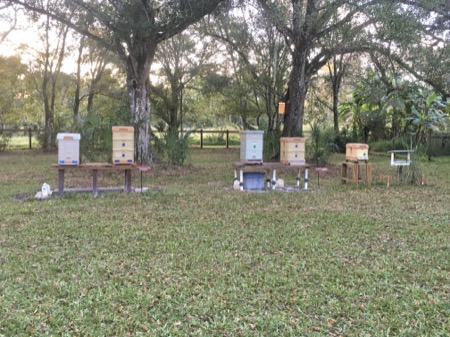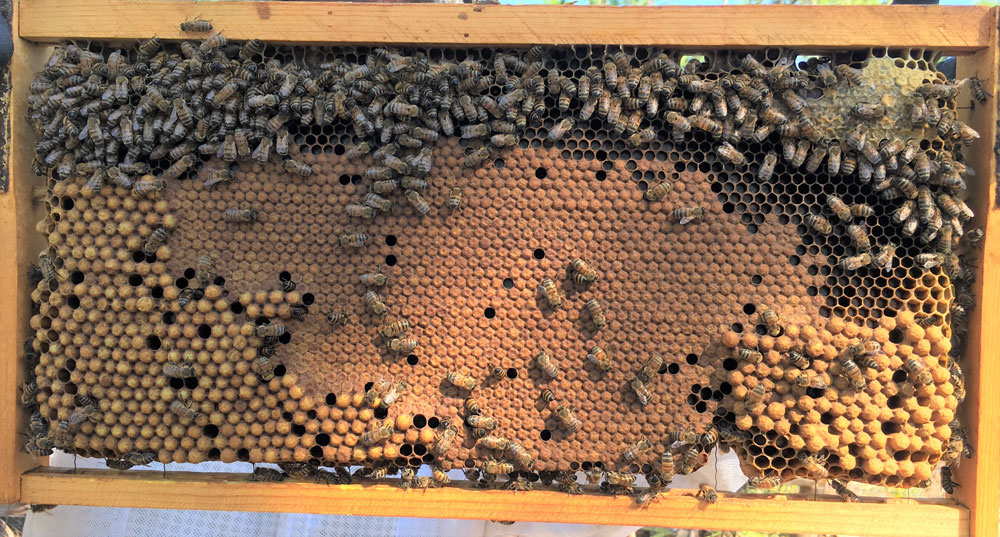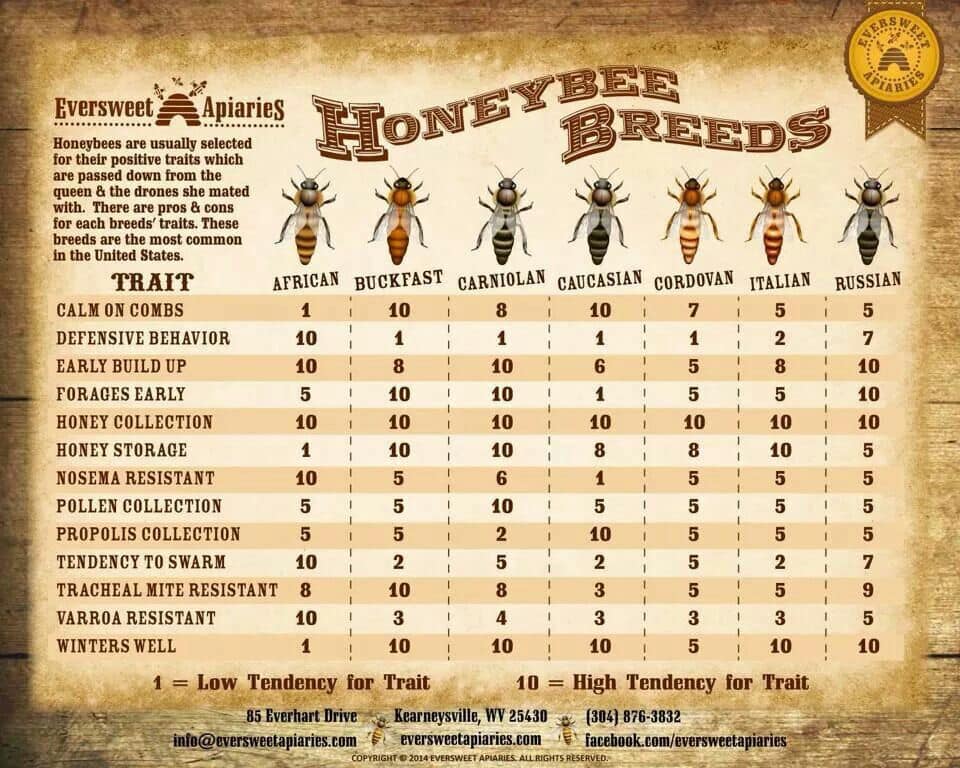 My 3 Apimaye hives, etc. |
Welcome to www.PaulMikkelsen.com/Personal/Bees Beekeeping Resources for Honey Bees Hopefully helpful... surely not comprehensive. Contact: |
 Honey, drone & worker brood |
| Web Pages: |
|
|
How to buy a Queen Honey BeeThis page is presently a FIRST DRAFT... it is "under construction".Last updated 19 Apr 2020, 20:13 EDT (Florida, USA) This page is not intended to tell you which queen(s) to buy, but rather to present to you a multitude of questions, thoughts, and concerns to guide you when considering purchase of a new queen... or several of them! To buy or not to buy... THAT is THE question! ...but, there are other questions too! But first, check out Jamie Ellis' article: Acquiring Bees and Queens Your colony needs a queen; no question about that! DECISION TIME! The first step in buying a queen is deciding whether or not you are going to do so. "They" say: Queens can live for 3-5 years (depending, in part, on location), but they can become unproductive after a couple years. Thus, some beekeepers replace queens annually... whether they need to or not! Alternatively, you can let the bees tell you that the queen needs to be replaced by looking at the signs: minimal brood, spotty brood pattern, supersedure cells being produced. Should you buy a mated queen or a virgin queen or maybe simply a queen cell to raise and mate on your own? Is your hive ready for a virgin queen... or, are drones locally available for mating? TIME IS MONEY! Letting the bees replace their queen can be costly, for both time and money. Plan on a month for them to do so, but plan on a full 7 weeks for the adult bee population to start to increase once again! The colony will build queen cells or supercedure cells when they notice the colony is queenless or the queen needs to be replaced. If the former (the queen died? swarmed away?), they must have freshly laid eggs or very young larvae available that are less then 3 days old; they will feed only royal jelly to the larvae which will then cause the egg to mature into an adult queen in 18 days. She then hangs around inside the hive for a few days, then goes on a mating flight (or sometimes two) and hopefully returns to the hive. If the queen does not return, then other maturing queens (if any!) must emerge, fly, mate and return. If no mated queen returns, the colony dies... unless you, the beekeeper, then provide a queen, or the resources (e.g, a couple frames of fresh eggs/larvae and a frame of honey & pollen from another healthy hive) to allow the colony another chance to requeen itself. All this takes time! Meanwhile, no new brood is created, fewer bees (as foragers die) collect nectar and pollen and thus, less honey is produced. Even when the new queen starts laying eggs, those eggs will require an additional 21 days to mature, emerge and become productive bees in the colony. WHEN TO BUY Of course, when you need a queen, that's a good time to buy! If regularly replacing queens, the early Spring time is often the time of choice. At that time of year, the flora is booming (and blooming!) or beginning to do so, making resources readily available to support expanding colonies. Whenever you choose to buy, you must (should!) plan ahead, especially if you plan to purchase many queens; Many commercial providers take orders well ahead of time and can rapidly run out of queens to provide. Having your queens arrive on the day you'd like can be a bit problematic. That said, there may be a local beekeeper (or two) that raises queens and may have one or more available when called upon. In the latter case, you'll likely get a "local" queen, locally mated... acclimated to the local area (see pros/cons, below). HOW TO CHOOSE A QUEEN Purchasing criteria must be considered, including cost, availability, vendor reliability, guarantees, etc. Dos the vendor require a minimum order? If perusing beekeeping magazines and websites, you'll be subjected to a barrage of "features" for a variety of queens. Each vendor will surely tout the desirable characteristics of their queens for sale, omitting mention of any lesser qualities or traits. This can be overwhelming! Bee genetics and characteristics must also be considered, including viability (mated? ...how?), easily located (marked?), aggressiveness (possible Africanized genetics?), variety/subspecies (Italian, Russian, Carniolan, Buckfast, etc... about 29 varieties!), breed (hygienic, varroa sensitive hygiene [VSH]). Do you want a queen that produces offspring that make more honey, despite a bad disposition? Do you want gentle bees regardless of low honey production levels? Do you want a queen that's cold tolerant (i.e., winter cold!), and thus her offspring too? Do you want a queen that is highly productive and creates lots of good pollinators for your crops, and you care little about how much honey is produced? From less expensive to more expensive, consider buying: a capped queen cell, a virgin queen, a marked virgin queen, a mated queen, and a marked mated queen. Queen cells have developing queens inside; the postal service is not gentle on packages, so consider a personal pickup from the vendor if this is your choice. A virgin queen is still developing her "lady parts" and, once you receive her, must mature and be mated locally... will she return to the hive? A mated queen has fully developed and has no ("good"?) reason to leave the hive; hopefully, she'll be accepted by the queenless colony (as all new queens must be) and will start laying eggs immediately upon release into the hive. A marked queen will be easier to locate, later on, and clearly has survived the marking process without damage. If you mark your queens yourself, you chance damaging her and losing your investment (time and money!). Marked queens will tell you, later on, if the colony has swarmed or not: if you still have a marked queen, then no swarming (or queen replacement) has occurred. Like many things, there may be discounts for quantity. Do the math: the cost for 6 queens (for example) MAY be the same as the cost for 5 queens due to a discount for quantities over 5. If timing is critical, buying an extra queen may be important, anticipating minor loss during shipping or the colony not accepting the new queen. SHIPPING How the queens are shipped to you may be important. Make sure the delivery service will deliver on they day they receive your queen(s)... letting them "sit" for a day in an office, warehouse,or truck may not be the best thing for them. Will they be shipped in "JZ-BZ Queen Cages" or in California Mini Queen Cages" or "Three-Hole Queen Cages" or in a "Battery Box"? The type of cage may be important, especially if attendants are included with the queen. [Note: I have no information on deciding which shipping cage would be more desirable for different situations of quantity, distance to travel, time of year (temperatures), etc.] Are the queens "banked" before shipping to you? Some vendors pull the queen from the queen-rearing colony the day she is shipped, while some. vendors cage the queens days before shipment, i.e., "banking" them. Banking of the queens is often done before the queens are fully mature and start to lay eggs (if mated), and can create more stress on the queens, likely decreasing probability of a successful shipment.. Is the queen shipped with "attendants"... a few worker bees to keep her company and attend to her needs? Adding attendants can add to the cost, but just a bit Shipping costs need to be of interest (and concern!) as they can be quite high for overnight shipping, in some cases up to $200 but generally less than half of that. Timing the arrival of your new queen is important on multiple counts. Will you be available to pick up the new queen when the shipment arrives at the shipping facility? Will you have the time available to promptly install the new queen(s)... assuming that you have quite a few of them to do. Acceptance of the new queen by the colony can be improved by having the hive queenless for 2-3 days. This facilitates the dissipation of pheromones from the old queen, thereby making the new queens scent more acceptable! Where will your queens be shipped TO? Delivery to your door may not happen. Many vendors will mark the shipment as "Hold at Facility" which will cause the shipment not to be delivered, but held at the local facility for you to come and pick up your shipment. Hopefully, this eliminates the possibility of live queens being cooked inside roadside mailboxes, etc. To maintain a vendors guarantee of live delivery of the queen(s), often you must pick up your order the morning that it arrives at the postal facility. Any guarantees in life? Possibly! Vendors will guarantee live delivery of the queen IF all parameters of ordering, shipping, and pick up are implemented. Note that if attendants are included with the queen, their live arrival may not (and likely not!) be guaranteed... just the queen!  ACCLIMATIZED but/vs AFRICANIZED Do you want a "home grown" queen or an "imported" queen? This question is important everywhere, but much more important in areas of severe winters or in areas influenced by Africanized genetics (e.g., in central and southern Florida, Texas, Arizona, Nevada, New Mexico, and southern California.). The issue of concern to "buy local" is that the queen will be acclimated to the region and therefore be a better and long-lasting queen, likely more tolerant of heat or cold, etc. These locally-grown queens are typically also mated with feral drones in the same area/region. This creates a situation where the resultant colony will be better suited to its surroundings. The issue with queens created and mated in areas that have experienced Africanized bees MAY mean that the queen has Africanized genetics and MAY have mated with some drones that possess Africanized genetics, thereby passing them on and perpetrating those aggressive genes. A similar situation can occur if an unmated queen is purchased from outside an area of African influence and then is feral-mated within such an area. This too can serve to perpetuate Africanized genetics. To truly get a mated queen without Africanized genes, one must purchase a mated queen from well outside an area of Africanized influence. The problem then implemented is that such a queen is likely not acclimated to the area of her destination. On the other hand, if one "imports" queen bees from areas non-local to their destination, they MAY bring in pathogens or pests not common to their destination. That said, realize that the purchased queen will be a young one which has had little time to have been infected. |